What Makes Indian Women Look Older—An Exploratory Study on Facial Skin Features
Abstract
:1. Introduction
2. Materials and Methods
2.1. Volunteers
2.2. Photographs Followed by Facial Attribute Assessment through Image Analysis
2.3. Grading of Ageing Signs
2.4. Probe Measurement
2.5. Silicone Rubber Replicas Analysed by Fringe Projection
2.6. Perceived Age Assessment by Naïve Graders
2.7. Self-Declared Skin Ageing Concerns
2.8. Statistical Analysis
2.8.1. Correlation of Skin Facial Attributes with Chronological and Perceived Ages
2.8.2. Age Perception Accuracy
2.8.3. Age Specific Relevance of Skin Ageing Features in Relation to Perceived Age
2.8.4. Self-Declared Skin Ageing Concerns of Naïve Graders
3. Results
3.1. Correlation of Skin Facial Attributes with Chronological and Perceived Age
3.2. Age Perception Accuracy
3.3. Age Specific Relevance of Skin Ageing Features in Relation to Perceived Age
3.4. Self-Declared Skin Ageing Concerns
4. Discussion
5. Conclusions
Supplementary Materials
Acknowledgments
Author Contributions
Conflicts of Interest
References
- Langlois, J.H.; Kalakanis, L.; Rubenstein, A.J.; Larson, A.; Hallam, M.; Smoot, M. Maxims or myths of beauty? A meta-analytic and theoretical review. Psychol. Bull. 2000, 126, 390–423. [Google Scholar] [CrossRef] [PubMed]
- Thornhill, R.; Grammer, K. The body and face of woman: One ornament that signals quality? Evol. Hum. Behav. 1998, 202, 105–120. [Google Scholar] [CrossRef]
- Facial Skincare China Mintel Report 2017. Available online: http://store.mintel.com/facial-skincare-china-august-2017 (accessed on 26 December 2017).
- Facial Skincare and Anti-Aging—US—Mintel Report 2017. Available online: http://store.mintel.com/us-facial-skincare-and-anti-aging-market-report (accessed on 26 December 2017).
- Glogau, R.G. Physiologic and structural changes associated with aging skin. Dermatol. Clin. 1997, 15, 555–559. [Google Scholar] [CrossRef]
- Bazin, R.; Doublet, E. Skin Aging Atlas: Volume 1, Caucasian Type; Editions Med’Com: Paris, France, 2007. [Google Scholar]
- Jackson, R. Elderly and sun-affected skin. Distinguishing between changes caused by aging and changes caused by habitual exposure to sun. Can. Fam. Phys. 2001, 47, 1236–1243. [Google Scholar]
- Flament, F.; Bazin, R.; Laquieze, S.; Rubert, V.; Simonpietri, E.; Piot, B. Effect of the sun on visible clinical signs of aging in Caucasian skin. Clin. Cosmet. Investig. Dermatol. 2013, 6, 221–232. [Google Scholar] [CrossRef] [PubMed]
- Morita, A. Tobacco smoke causes premature skin aging. J. Dermatol. Sci. 2007, 48, 169–175. [Google Scholar] [CrossRef] [PubMed]
- Hüls, A.; Vierkötter, A.; Gao, W.; Krämer, U.; Yang, Y.; Anan, D.; Stolz, S.; Matsui, M.; Kan, H.; Wang, S.; Jin, L.; Krutmann, J.; et al. Traffic related air pollution contributes to development of facial lentigines: Further epidemiological evidence from Caucasians and Asians. J. Investig. Dermatol. 2016, 136, 1–3. [Google Scholar] [CrossRef] [PubMed]
- Christensen, K.; Iachina, M.; Rexbye, H.; Tomassini, C.; Frederiksen, H.; McGue, M.; Vaupel, J.W. “Looking old for your age”: Genetics and mortality. Epidemiology 2004, 15, 251–252. [Google Scholar] [CrossRef] [PubMed]
- Christensen, K.; Thinggaard, M.; McGue, M.; Rexbye, H.; Hjelmborg, J.V.B.; Aviv, A.; Gunn, D.; Van der Ouderaa, F.; Vaupel, J.W. Perceived age as clinically useful biomarker of ageing: Cohort study. BMJ 2009, 339. [Google Scholar] [CrossRef]
- Gunn, D.; Rexbye, H.; Griffiths, C.E.M.; Murray, P.G.; Fereday, A.; Catt, S.D.; Tomlin, C.C.; Strongitharm, B.H.; Perrett, D.I.; Catt, M.; et al. Why some women look young for their age. PLoS ONE 2009, 4, e8021. [Google Scholar] [CrossRef] [PubMed] [Green Version]
- Merinville, E.; Grennan, G.Z.; Gillbro, J.M.; Mathieu, J.; Mavon, A. Influence of facial skin ageing characteristics on the perceived age in a Russian female population. Int. J. Cosmet. Sci. 2015, 37, 3–8. [Google Scholar] [CrossRef] [PubMed]
- Fink, B.; Matts, P.J. The effects of skin colour distribution and topography cues on the perception of female facial age and health. J. Eur. Acad. Dermatol. Venereol. 2008, 22, 493–498. [Google Scholar] [CrossRef] [PubMed]
- Porcheron, A.; Mauger, E.; Russell, R. Aspects of facial contrast decrease with age and are cues for age perception. PLoS ONE 2013, 8, e57985. [Google Scholar] [CrossRef] [PubMed]
- De Rigal, J.; Des Mazis, I.; Diridollou, S.; Querleux, B.; Yang, G.; Leroy, F.; Barbosa, V.H. The effect of age on skin color and color heterogeneity in four ethnic groups. Skin Res. Technol. 2010, 16, 168–178. [Google Scholar] [CrossRef] [PubMed]
- Noveau-Richard, S.; Yang, Z.; Mac-Mary, S.; Li, L.; Bastien, P.; Tardy, I.; Bouillon, C.; Humbert, P.; de Lacharrière, O. Skin Ageing: A comparison between Chinese and European populations. J. Dermatol. Sci. 2015, 40, 187–193. [Google Scholar] [CrossRef] [PubMed]
- Muizzuddin, N.; Hellemans, L.; Van Overloop, L.; Corstjens, H.; Declercq, L.; Maes, D. Structural and functional differences in barrier properties of African American, Caucasian and East Asian skin. J. Dermatol. Sci. 2010, 59, 123–128. [Google Scholar] [CrossRef] [PubMed]
- Hellemans, L.; Muizzuddin, N.; Declercq, L.; Maes, D. Characterization of stratum corneum properties in human subjects from a different genetic background. J. Investig. Dermatol. 2005, 124, A62. [Google Scholar]
- Mayes, A.E.; Murray, P.G.; Gunn, D.A.; Tomlin, C.C.; Catt, S.D.; Wen, Y.B.; Zhou, L.P.; Wang, H.Q.; Catt, M.; Granger, S.P. Ageing appearance in China: biophysical profile of facial skin and its relationship to perceived age. J. Eur. Acad. Dermatol. Venereol. 2010, 24, 341–348. [Google Scholar] [CrossRef] [PubMed]
- Porcheron, A.; Latreille, J.; Jdid, R.; Tschachler, E.; Morizot, F. Influence of skin ageing features on Chinese women’s perception of facial age and attractiveness. Int. J. Cosmet. Sci. 2014, 36, 312–320. [Google Scholar] [CrossRef] [PubMed]
- Flament, F.; Bazin, R.; Ye, C.; Laquieze, S.; Rubert, V.; Decroux, A.; Simonpietri, E.; Piot, B. Solar exposure (s) and facial clinical signs of aging in Chinese women: Impacts upon age perception. Clin. Cosmet. Investig. Dermatol. 2015, 8, 75–84. [Google Scholar] [CrossRef] [PubMed]
- Mayes, A.E.; Murray, P.G.; Gunn, D.A.; Tomlin, C.C.; Catt, S.D.; Wen, Y.B.; Zhou, L.P.; Wang, H.Q.; Catt, M.; Granger, S.P. Environmental and lifestyle factors associated with perceived facial age in Chinese women. PLoS ONE 2010, 5, e15270. [Google Scholar] [CrossRef] [PubMed]
- Hourblin, V.; Nouveau, S.; Roy, N.; de Lacharriere, O. Skin complexion and pigmentary disorders in facial skin of 1204 women in 4 Indian cities. Indian J. Dermatol. Venereol. Leprol. 2014, 80, 395–401. [Google Scholar] [CrossRef] [PubMed]
- Bernois, A.; Huber, A.; Derome, C.; Drouault, Y.; de Quéral, D.; Schnebert, S.; Perrier, E.; Heusèle, C. A photographic scale for the evaluation of facial skin aging in Indian women. Eur. J. Dermatol. 2011, 21, 700–704. [Google Scholar] [PubMed]
- Arce-Lopera, C.; Igarashi, T.; Nakao, K.; Okajima, K. Image statistics on the age perception of human skin. Skin Res. Technol. 2013, 19, 273–278. [Google Scholar] [CrossRef] [PubMed]
- Nkengne, A.; Bertin, C.; Stamatas, G.N.; Giron, A.; Rossi, A.; Issachar, N.; Fertil, B. Influence of facial skin attributes on the perceived age of Caucasian women. J. Eur. Acad. Dermatol. Venereol. 2008, 22, 982–991. [Google Scholar] [CrossRef] [PubMed]
- Verma, S.B. Obsession with light skin–shedding some light on use of skin lightening products in India. Int. J. Dermatol. 2010, 49, 464–465. [Google Scholar] [CrossRef] [PubMed]
- Li, E.P.H.; Min, H.J.; Belk, R.W.; Kimura, J.; Bahl, S. Skin lightening and beauty in four Asian cultures. Adv. Consum. Res. 2008, 35, 444–449. [Google Scholar]
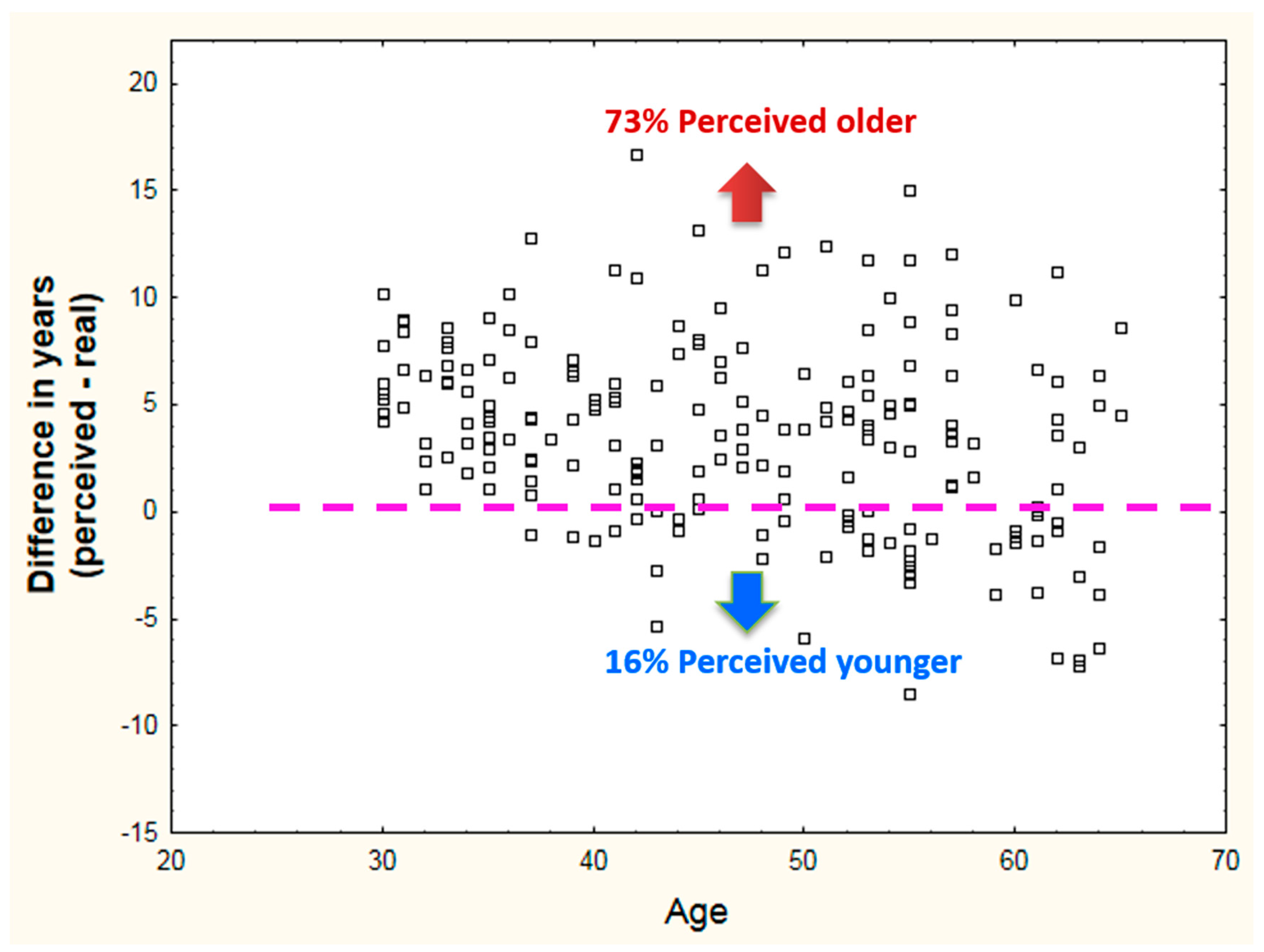
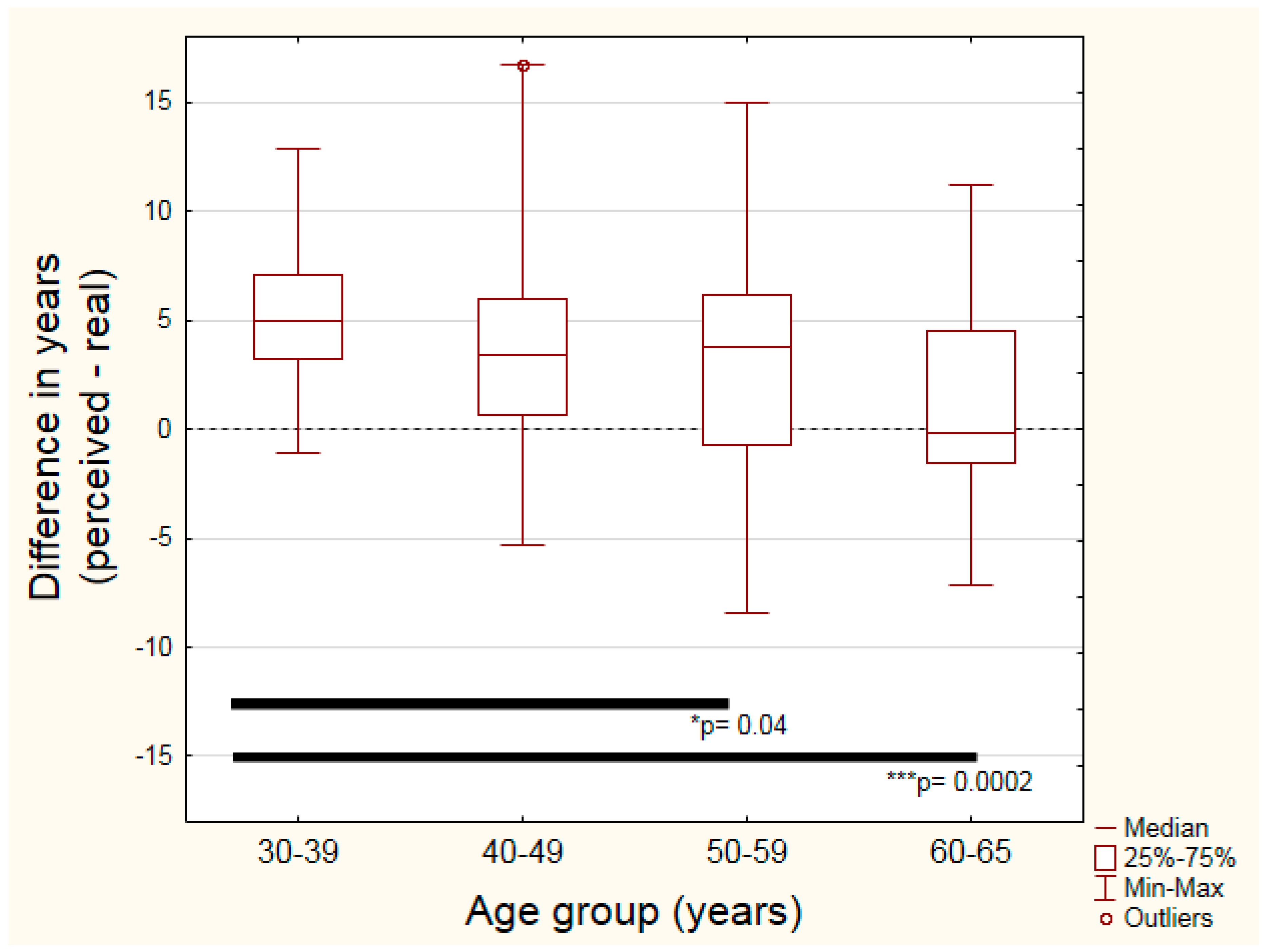

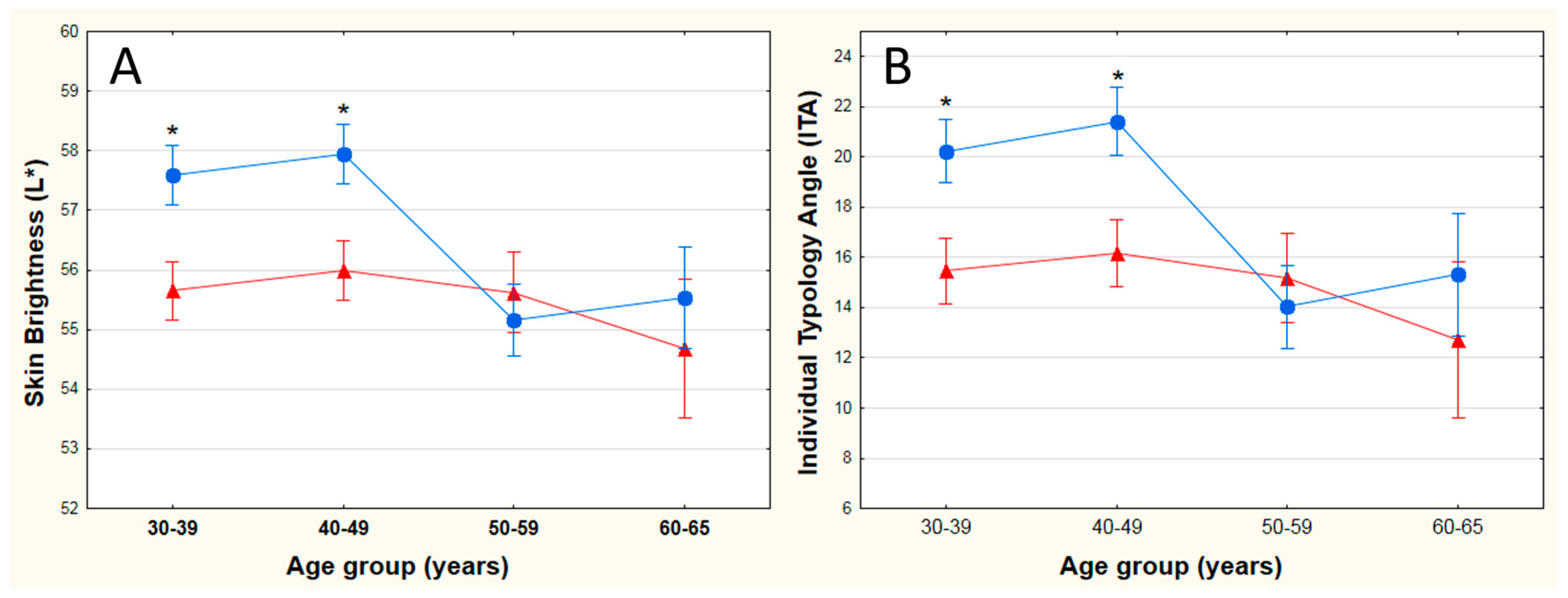
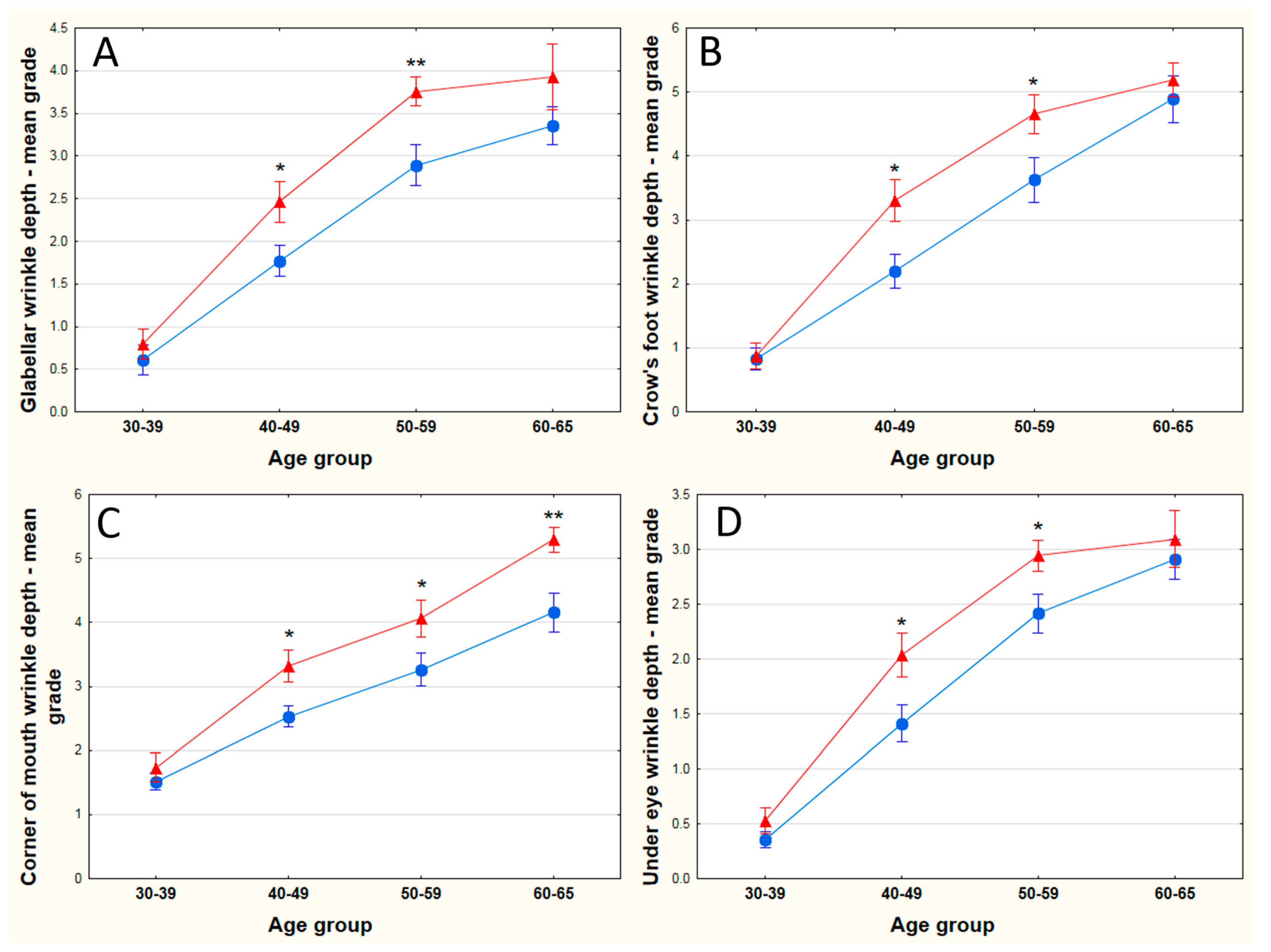
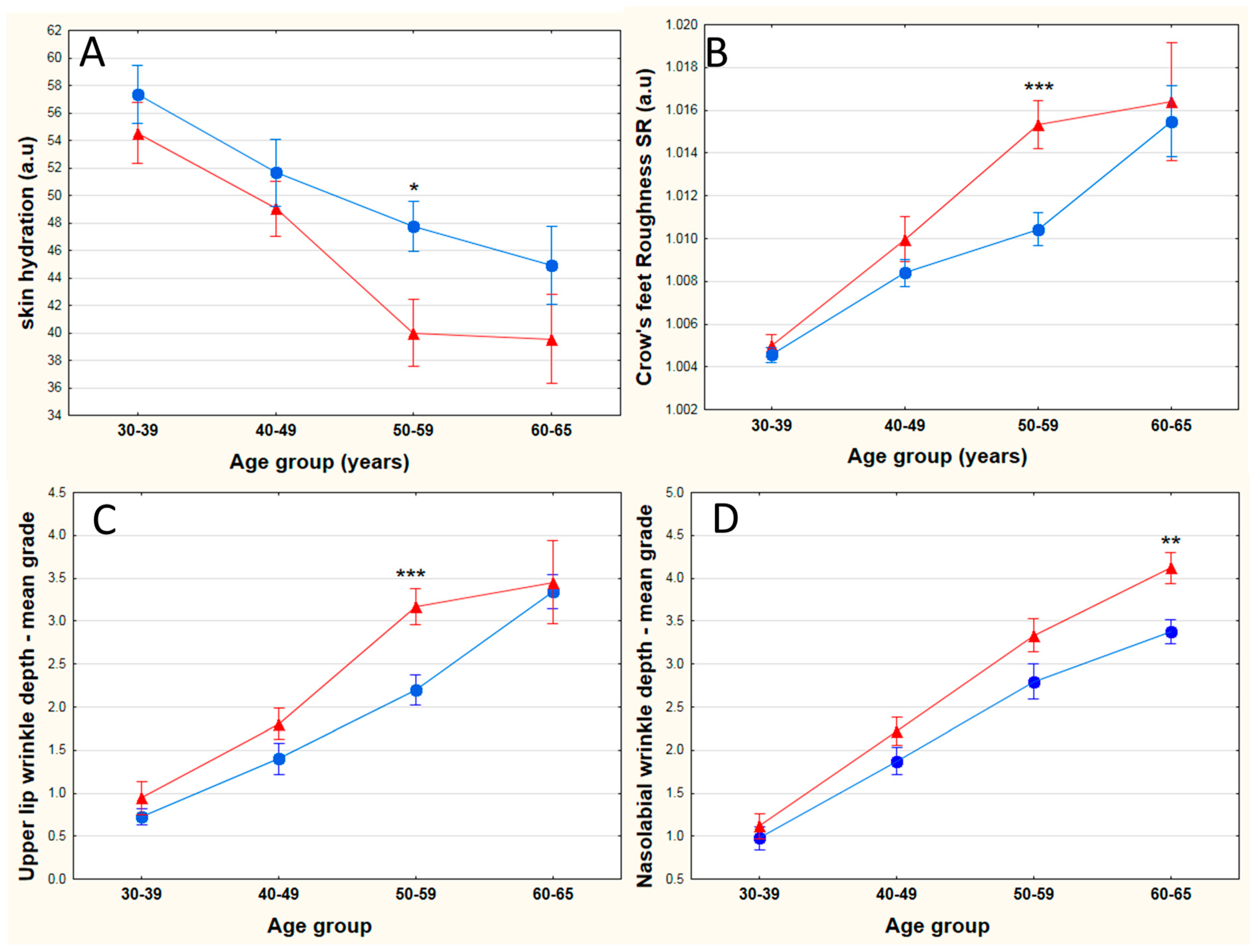
| Technique/Instrument | Feature measured | Category |
|---|---|---|
| Expert grading on photo | Crow’s feet wrinkle depth | Wrinkle/texture |
| Expert grading on photo | Number of crow’s feet wrinkles | |
| Expert grading on photo | Nasolabial wrinkle depth | |
| Expert grading on photo | Upper lip wrinkle depth | |
| Expert grading on photo | Corner of the mouth wrinkle Depth | |
| Expert grading on photo | Glabellar wrinkle depth | |
| Expert grading on photo | Under eye wrinkle depth | |
| Expert grading on photo | Forehead wrinkle depth | |
| DermaTOP on replica | Skin roughness on the crow’s Feet Area (SR) | |
| Visia CA software | Overall skin roughness | |
| Visia CA software | Pore severity | |
| Visia CA software | Number of localised red areas | Skin Colour |
| Visia CA software | Severity of localised red areas | |
| Visia CA software | Number of brown spots | |
| Visia CA software | Severity of brown spots | |
| Visia CA software | UV spots number | |
| Visia CA software | Severity of UV spots | |
| Chromameter | Skin brightness (L*) | |
| Image Pro Plus on photo | Under eye dark circle severity | |
| Chromameter | Skin sallowness (b*) | |
| Image Pro Plus on photo | Skin colour intensity (C) | |
| Chromameter | Skin Colour (ITAº) | |
| Chromameter | Cheek redness (a*) | |
| Image Pro Plus on photo | Facial colour unevenness | |
| Corneometer | Skin hydration | Biophysical |
| Sebumeter | Skin oiliness | |
| Cutometer | Skin elasticity (R5) | |
| Cutometer | Skin laxity (F4) |
| Feature | Chronological Age Pearson Coefficient (p-Value) | Perceived Age Pearson Coefficient (p-Value) |
|---|---|---|
| Crow's feet wrinkle depth | 0.750 (p < 0.001) | 0.773 (p < 0.001) |
| Number of crow's feet wrinkles | 0.541 (p < 0.0001) | 0.568 (p < 0.0001) |
| Nasolabial fold wrinkle depth | 0.765 (p < 0.001) | 0.795 (p < 0.001) |
| Upper lip wrinkle depth | 0.707 (p < 0.001) | 0.740 (p < 0.001) |
| Forehead wrinkle depth | 0.626 (p < 0.001) | 0.675 (p < 0.001) |
| Glabellar wrinkle depth | 0.735 (p < 0.001) | 0.794 (p < 0.001) |
| Under eye wrinkle depth | 0.773 (p < 0.001) | 0.797 (p < 0.001) |
| Corner of the mouth wrinkle depth | 0.665 (p < 0.001) | 0.691 (p < 0.001) |
| Roughness of the crow’s feet area | 0.769 (p < 0.001) | 0.815 (p < 0.001) |
| Overall skin roughness | 0.472 (p < 0.0001) | 0.511 (p < 0.0001) |
| Severity of pores | 0.311 (p < 0.0001) | 0.288 (p < 0.0001) |
| Colour Code for Correlation Strength and Direction | ||
| r < 0.4 | 0.4 < r < 0.7 | r ≥ 0.7 |
| r < −0.4 | −0.4 < r < −0.7 | r ≥ −0.7 |
| Feature | Chronological Age Pearson Coefficient (p-Value) | Perceived Age Pearson Coefficient (p-Value) |
|---|---|---|
| UV spot number | 0.263 (p < 0.0001) | 0.191 (p < 0.01) |
| Severity of UV spots | 0.445 (p < 0.0001) | 0.463 (p < 0.0001) |
| Number of brown spots | 0.313 (p < 0.0001) | 0.328 (p < 0.0001) |
| Severity of brown spots | 0.316 (p < 0.0001) | 0.48 (p < 0.0001) |
| Number of localised red areas | 0.509 (p < 0.0001) | 0.477 (p < 0.0001) |
| Severity of localised redness | 0.550 (p < 0.0001) | 0.592 (p < 0.001) |
| Skin brightness | −0.186 (p < 0.01) | −0.257 (p < 0.0001) |
| Skin sallowness | −0.412 (p < 0.0001) | −0.409 (p < 0.0001) |
| Skin colour (ITA) | −0.181 (p < 0.05) | −0.253 (p < 0.0001) |
| Cheek redness | −0.008 (p = 0.905) | −0.014 (p = 0.839) |
| Facial colour unevenness | 0.117 (p = 0.098) | 0.075 (p = 0.287) |
| Under eye dark circles | 0.068 (p = 0.335) | 0.056 (p = 0.432) |
| Colour intensity | −0.164 (p < 0.05) | −0.213 (p < 0.01) |
| Colour Code for Correlation Strength and Direction | ||
| r < 0.4 | 0.4 < r < 0.7 | r ≥ 0.7 |
| r < −0.4 | −0.4 < r < −0.7 | r ≥ −0.7 |
| Feature | Chronological Age Pearson Coefficient (p-Value) | Perceived Age Pearson Coefficient (p-Value) |
|---|---|---|
| Skin hydration | −0.408 (p < 0.0001) | −0.486 (p < 0.0001) |
| Skin oiliness | −0.044 (p = 0.530) | −0.05 (p = 0.481) |
| Skin elasticity (R5) | −0.630 (p < 0.001) | −0.618 (p < 0.001) |
| Skin laxity (F4) | 0.315 (p < 0.0001) | 0.298 (p < 0.0001) |
| Colour Code for Correlation Strength and Direction | ||
| r < 0.4 | 0.4 < r < 0.7 | r ≥ 0.7 |
| r < −0.4 | −0.4 < r < −0.7 | r ≥ −0.7 |
| Chronological Age Groups | 30–39 | 40–49 | 50–59 | 60–65 |
|---|---|---|---|---|
| Median age difference (perceived–real) | 4.92 years | 3.40 years | 3.73 years | −0.15 years |
| Younger group—volunteers below median age difference (N) | 29 | 29 | 28 | 15 |
| Older group—volunteers above median age difference (N) | 29 | 29 | 29 | 14 |
© 2017 by the authors. Licensee MDPI, Basel, Switzerland. This article is an open access article distributed under the terms and conditions of the Creative Commons Attribution (CC BY) license (http://creativecommons.org/licenses/by/4.0/).
Share and Cite
Merinville, E.; Messaraa, C.; O’Connor, C.; Grennan, G.; Mavon, A. What Makes Indian Women Look Older—An Exploratory Study on Facial Skin Features. Cosmetics 2018, 5, 3. https://doi.org/10.3390/cosmetics5010003
Merinville E, Messaraa C, O’Connor C, Grennan G, Mavon A. What Makes Indian Women Look Older—An Exploratory Study on Facial Skin Features. Cosmetics. 2018; 5(1):3. https://doi.org/10.3390/cosmetics5010003
Chicago/Turabian StyleMerinville, Eve, Cyril Messaraa, Carla O’Connor, Gemma Grennan, and Alain Mavon. 2018. "What Makes Indian Women Look Older—An Exploratory Study on Facial Skin Features" Cosmetics 5, no. 1: 3. https://doi.org/10.3390/cosmetics5010003




